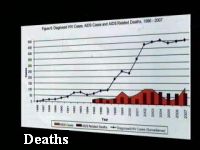
You’ve seen the ads, the billboards, heard the songs –
but no matter how much public awareness is put out there – the Aids numbers
just continue to climb. There were two-thousand, two hundred and twenty one
cases of HIV reported between 2003 and 2007 and the majority of them were males;
most of the cases came from the Belize District and most are aged between 15
and 49 years old. Belize still has the highest prevalence rate of HIV in Central
America and the third highest in the Caribbean – behind the Bahamas and
Haiti.
Today all that was put on the table as the Ministry of Health presented
its epidemiological profile from 2003 to 2007. It’s an important four
year benchmark and a time for stock-taking to see what has been working and
what hasn’t. Here’s what the numbers show.
Jules Vasquez Reporting,
The numbers are out – in this report and they are not good. Most worryingly
it shows that fewer people are being tested - that’s the purple line,
and – from that smaller group – more people are turning up positive-
that’s the blue line.
Ethan Gough, Ministry of Health
“We are seeing a significant reduction in the number of people who
have been tested on an annual basis by the public system. We don’t really
know how many tests are done in private facilities but for the Ministry of Health  we have seen like I said a significant reduction in the number of tests that
we have done.”
we have seen like I said a significant reduction in the number of tests that
we have done.”
To underscore that it is a priority Minister of Health Pablo Marin volunteered
for his test today:
Ruth Jaramillo, National Aids Commission
“More people need to go forward with testing and we need to ask the
question: what is preventing persons from going forward.”
And while many more women are tested, that’s the pink bar, men have a
significantly higher rate of HIV infection, that’s the blue line which
spiked up last year. AIDS related deaths – that’s the brown bar
at the bottom – have been more or less stable but there are more people
living with HIV and AIDS.
New cases of HIV are being most reported in the Belize District – that’s
the green line way at the top and Stann Creek – that’s the purple
line about a quarter ways up. And while those are new infections, cases of full
blown AIDS are highest in the Belize District – that’s the Yellow
line with Cayo – the black line and Stann Creek having the second and
third most cases.
Ruth Jaramillo,
“Based on this information as you rightly pointed out we need to rethink
our strategies: what it is we’re doing right and what is it we need to  change or focus on and what are the areas of support that we need to engage
in.”
change or focus on and what are the areas of support that we need to engage
in.”
But they need to come up with solutions quickly and that means reaching out
and testing those who have gone undetected.
Dr. Marvin Manzanero, National Aids Program
“I think what we need to do as Ethan mentioned in his presentation
is target those specific high risk groups that seem to be invisible to the health
system; the female sex workers, the men who have sex with men, the partners
of men who have sex with men. Those factors or those groups within society that
are considered to be vulnerable, we need to start making strategies to better
be able to reach them. By 2012 if we keep on with the strategies that we have
implemented and put on newer strategies, and I think we’re talking about
marketing strategies in prevention efforts, we may able to start making a dent
by 2015. I don’t think we’re doing planning for this year or next
year. It is a long term planning process.”
And in the short term, there are successes to report.
Ruth Jaramillo,
“For example the prevention of mother to child, what that indicates
for us is a positive way forward. Why? Because when you do that program you  are actually representing the general population. You heard prevalence is 1.3
overall. That means that when you do an intervention with that population you
have a higher impact on the general population. And one important thing that
was not emphasized Jules is that less people are actually dying of Aids. That’s
a big achievement also. That reflects that the disease is now being addressed
more chronical, like the way it is supposed to be as a chronic disease.”
are actually representing the general population. You heard prevalence is 1.3
overall. That means that when you do an intervention with that population you
have a higher impact on the general population. And one important thing that
was not emphasized Jules is that less people are actually dying of Aids. That’s
a big achievement also. That reflects that the disease is now being addressed
more chronical, like the way it is supposed to be as a chronic disease.”
One Doctor, Cardo Martinez said they have made strides that no statistic can
measure:
Dr. Cardo Martinez, Paediatrician
“We’ve come a very very far way. I remember when we had kids
that came in to the ward and nobody wanted to touch them. That’s not a
hundred years ago man. Come on, I am younger than a lot of you here and a little
bit older than most of you. I remember when we had to use our own vehicles because
there was no transport in the Ministry of Health. You can’t take that
for granted man, that is a cost – that is a commitment to this nation,
that is conviction to its people. You can’t take that lightly man.”
Gough estimates that there is 30% under-reporting – which means
that for every three cases reported, one goes un-reported. About 80 people die
per year from Aids related conditions in Belize.



